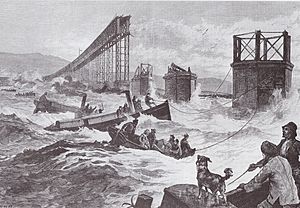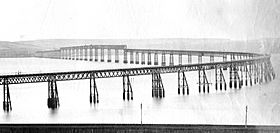Tay Bridge disaster facts for kids
The Tay Bridge disaster was one of the great engineering disasters of the 19th century. It happened during a violent storm on 28 December 1879. The first Tay Rail Bridge collapsed while a train was passing over it from Wormit to Dundee, killing all aboard.
Contents
First rail bridge
The Tay Bridge was designed by noted railway engineer Thomas Bouch, who received a knighthood when the bridge was completed. It was a lattice-grid design, combining cast and wrought iron. The design was well known, having been successfully used in the Crumlin Viaduct in South Wales in 1858.
An earlier cast iron design, the Dee bridge which collapsed in 1847, failed due to poor use of cast-iron girders. In 1867 Gustave Eiffel used a similar design to build several large viaducts in the Massif Central.
Plans to build a bridge across the River Tay date back to at least 1854. The North British Railway (Tay Bridge) Act received the Royal Assent on 15 July 1870 and the foundation stone was laid on 22 July 1871.
The bridge design: the basic idea
The original design was for lattice girders supported by brick piers resting on bedrock. Test drilling showed the rock was not far below the river. At either end of the bridge the single rail track ran on top of the bridge girder, most of which lay below the pier tops. However, in the middle section of the bridge (the “high girders”) the railway ran inside the bridge girder, which could then run above the pier tops. This made the bridge high enough to allow sailing ships to travel up the river to Perth.
However as the bridge extended out into the river, it became clear in December 1873, that the bedrock really lay much deeper. It was too deep to act as a foundation for the bridge piers. Bouch had to redesign the bridge. He reduced the number of piers and increased the span of the girders. The pier foundations were no longer taken down to bedrock; instead they were built by sinking brick-lined wrought-iron caissons onto the riverbed,
The work
The company which had the contract for building the bridge went bankrupt while Bouch was redesigning the bridge. The new company did poor work. Almost every part of the bridge was substandard, including the iron and the ties and fixings. Lack of precision in the bolts and braces led to on-site fixes, described by one witness at the later inquiry as "about as slovenly a piece of work as ever I saw in my life".
Opening
The bridge was opened for passenger traffic on 1 June 1878. The next year, on June 20 1879, Queen Victoria crossed the bridge to return south from Balmoral. Bouch was presented to her before she did so, and on June 26th 1879 he was knighted by the Queen at Windsor Castle.
The Tay Bridge Disaster
On the night of 28 December 1879 at 7.15pm, the bridge collapsed after its central spans gave way during high winter gales. A train with six carriages carrying 75 passengers and crew, crossing at the time of the collapse, fell into the icy waters of the Tay. All 75 were killed. The disaster stunned the whole country and sent shock waves through the Victorian engineering community.
At the time a gale of about force ten or eleven (Tropical Storm force winds: 55–72 mph/80–117 km/hr) had been blowing down the Tay estuary at right angles to the bridge. The engine itself was salvaged from the river and repaired for service on the railways.
The collapse of the bridge, opened only 19 months earlier and passed as safe by the Board of Trade, is still the most famous bridge disaster in the British Isles. The stumps of the original bridge piers can still be seen above the surface of the Tay even at high tide.
Report of the Court of Inquiry
Causes
The inquiry said that "the fall of the bridge was occasioned by the insufficiency of the cross-bracings and fastenings to sustain the force of the gale on the night of December 28th 1879 and that the bridge had been previously strained by other gales."
However, this is not a finding that the bridge as designed would have failed. The engineer who carried out a detailed report on the bridge design said:
- "Wind-pressure alone (supposing the structure to have been perfectly made, and so designed) to the amount of 37 lbs to the square foot would have overthrown it, but that, being perfect, it fell in consequence of an excess of wind-pressure is evidently not the case, [because] it did not fall upon those points which would have been the least lines of resistance had the structure been perfect. The mode in which it fell shows that there must have been weak points in the structure and that, with the knowledge which I have [of parts which already had to be repaired], ... shows me that the structure was not in that perfect condition".
The section in the middle of the bridge, where the rail ran inside high girders, was likely to be top-heavy and very vulnerable to high winds. Neither Bouch nor the builders appeared to have regularly visited the on-site foundry where iron from the earlier half-built bridge was recycled. The cylindrical cast iron columns supporting the 13 longest spans of the bridge, each 245 ft (75 m) long, were of poor quality. Many had been cast horizontally, with the result that the walls were not of even thickness. There was some evidence that poor quality work was hidden from the (very inadequate) quality control inspections.
In particular, some of the lugs used as attachment points for the wrought iron bracing bars had been "burnt on" rather than cast with the columns. Even the normal lugs were very weak. They were tested for the Inquiry, and proved to break at only about 20 long tons (20 t) rather than the expected load of 60 long tons (61 t). These lugs failed and weakened the entire middle of the bridge during the storm.
Put into simple words, the bridge failed because of defects in its manufacture. This meant it did not reach the standards of wind resistance planned by the designer.
- Report of the Court of Inquiry and report of Mr Rothery. Stationery Office, London 1880. [1]
- Tay Bridge Disaster: Appendix to the Report Of The Court of Inquiry. [2]
Images for kids
See also
 In Spanish: Desastre del puente del Tay para niños
In Spanish: Desastre del puente del Tay para niños













